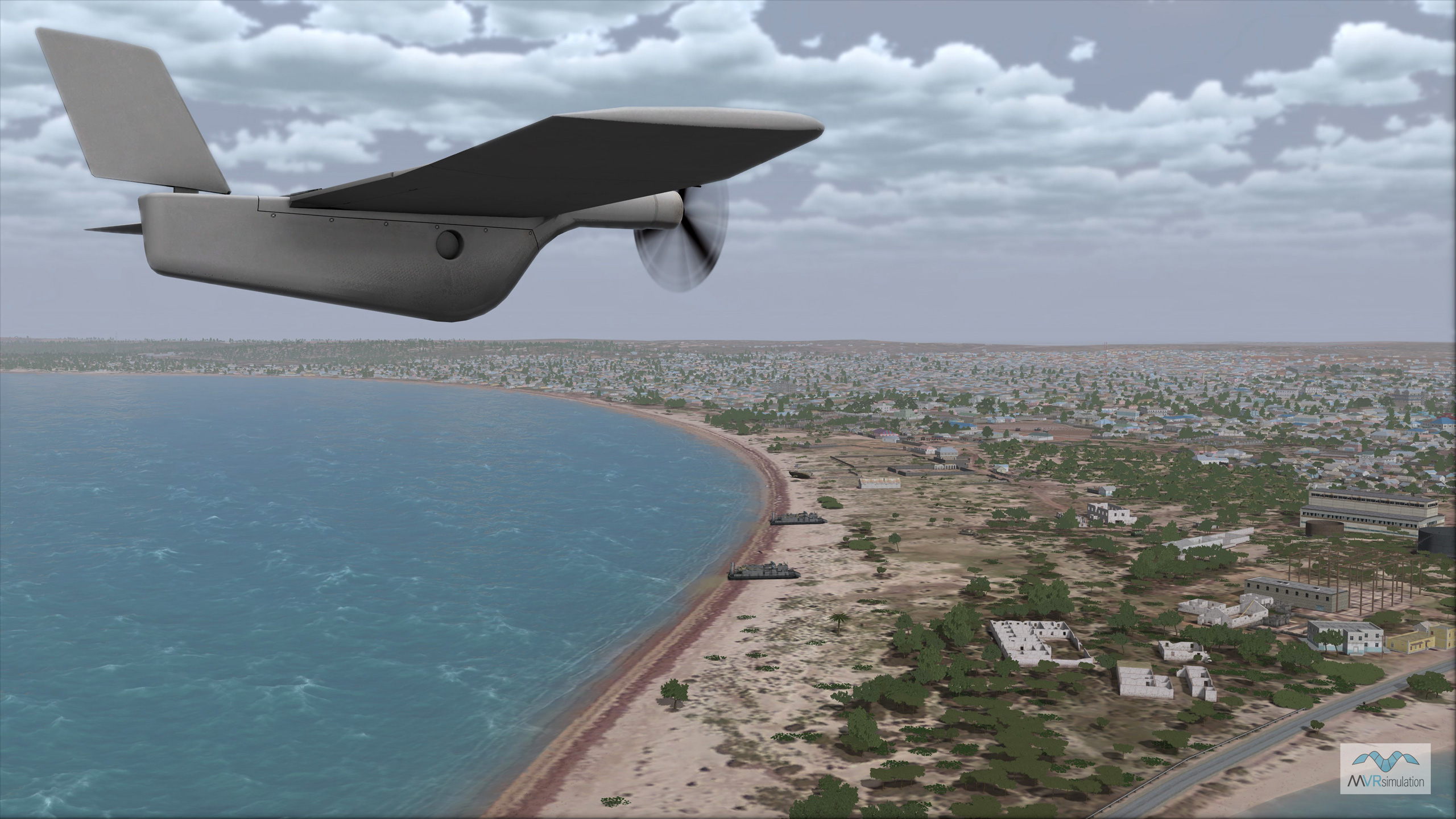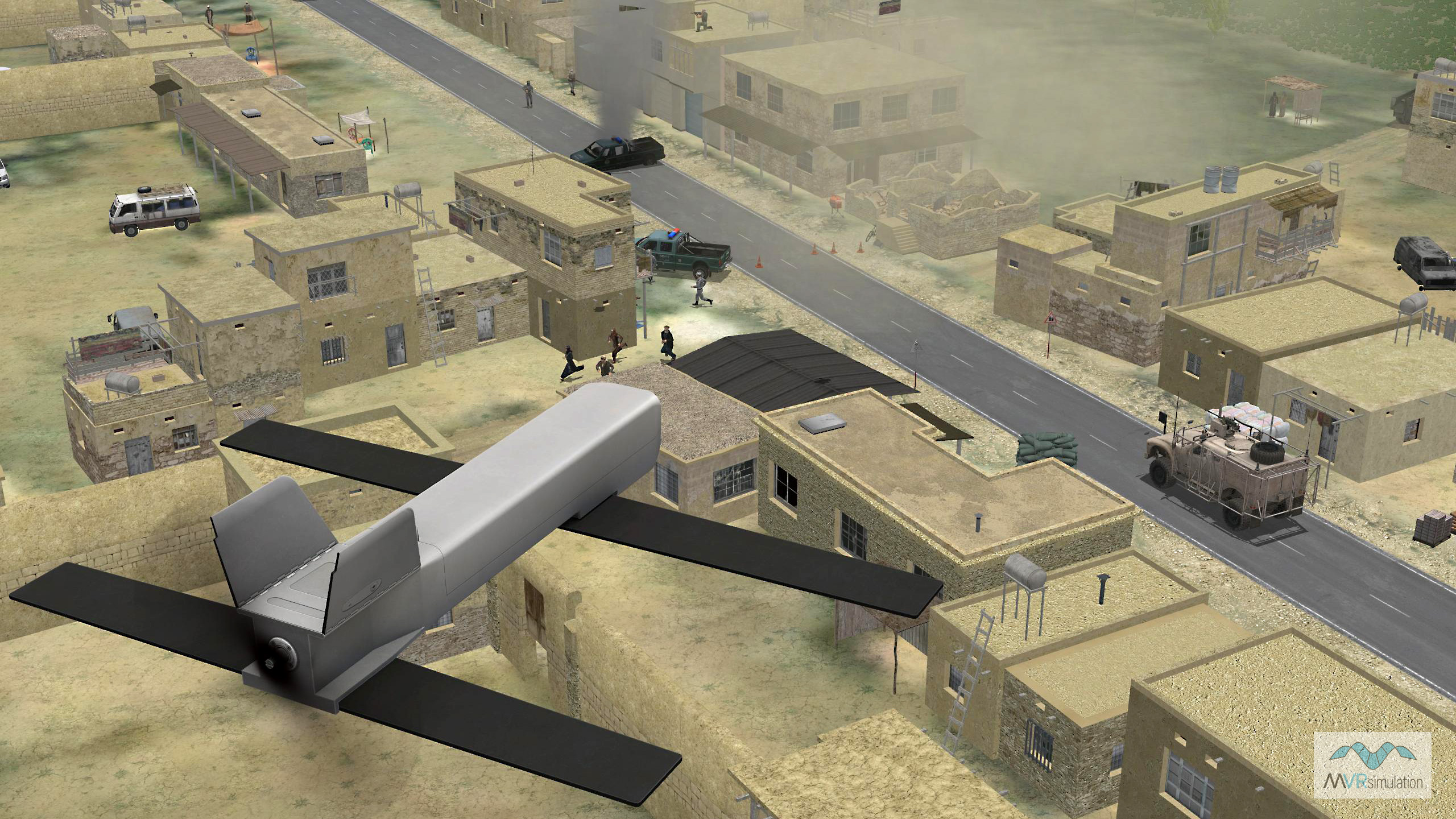Micro-UAV and SUGV Urban Training Environment

MVRsimulation VRSG real-time scene featuring a Wasp III Battlefield Air Targeting Micro Air Vehicle (BATMAV) in flight over the virtual port city of Kismayo, Somalia.
MVRsimulation has developed high-resolution 3D urban terrain and vehicle models needed to create a virtual testbed for Small Unit Level Unmanned Aerial Vehicle (UAV) Systems or SUGV systems for proposed vehicle design evaluation.
Vendors that produce highly mobile and deployable UAV systems to support company- and platoon-level operations that are day/night ISR-capable can test their designs and operation tactics in VRSG using a MVRsimulation urban terrain database and military vehicle model library of current and future vehicle designs (and provide their own).
A US Government military command would distribute this virtual test environment in advance of candidate evaluations such that each vendor could incorporate and test their computer or hardware in the loop models of their UAV subsystems prior to on site experiments at the actual MOUT facility: air vehicle, launcher, Intelligence, Surveillance and Reconnaissance (ISR) payload, data link(s), and operator control unit.
Potential systems could range from pocket-sized, backpack-portable, to single High-Mobility Multipurpose Wheeled Vehicle (HMMWV) transportable UAVs. The 3D terrain would be available in industry-standard formats with no redistribution fees; vendors would use the Distributed Interactive Simulation (DIS) networking technology to support multiple and concurrent live and constructive participant simulations. MVRsimulation VRSG can simulate the camera or sensor views of what the UAV prototype would display to an operator. The sensor views in VRSG can be configured to match the capabilities of a vendor's UAV.
The Small Unit Level Unmanned Aerial Systems (SUAS) testbed would provide for testing many different permutations of UAV configurations and launch techniques. Ultimately vendor vehicle computer models would be incorporated into a base line standard Government simulation for further testing and eventually as part of a UAV simulation or SUGV training infrastructure. This network-centered collective simulation environment would provide for combined operations experiments and training for individual unit tactics using proposed or fielded UAV designs. Unit level tasks such as the Forward Observer (FO), Close Air Support (CAS) or JTAC roles in conjunction with a call for artillery fire missions can be simulated in this urban environment.Enabling soldiers to fight in simulated dense urban environments with advanced technology place greater challenges on system developers and training environments than was previously experienced in the modeling and simulation industry. With MVRsimulation simulation technology, you can prototype and develop training systems for new technology and then test the systems in a simulated urban environment that very closely matches reality.

MVRsimulation VRSG real-time scene featuring a Switchblade UAV entity hovering over the high-resolution modeled village on virtual Afghanistan terrain.
Simulating realistic MOUT sites requires the image generator to manage high polygon counts while processing high-resolution photorealistic imagery of the terrain and photorealistic buildings developed from CAD drawings in real-time (60 Hz). Terrain elevation and building geometry must precisely match the real urban environment to provide valid experimental data so that the simulation tells the user an accurate story of how the system would actually behave in the real world.
With MVRsimulation technology, you can simulate future proposed urban warfare capabilities such as:
- Small UAVs that can hover outside windows.
- UAVs that can perch as a surveillance system.
- Backpack-sized UAV systems that are easy to use for military personnel to operate.
- Micro-UAV and unmanned ground vehicle joint collaboration.
Individual combatants are simulated in VRSG's First Person Simulator mode. The UAV (or UAS) is typically simulated by systems such as the MUSE.
